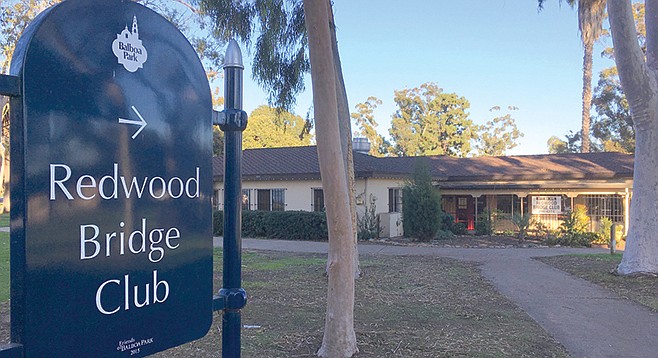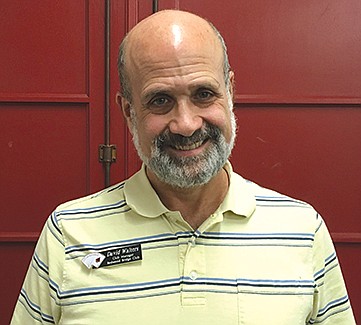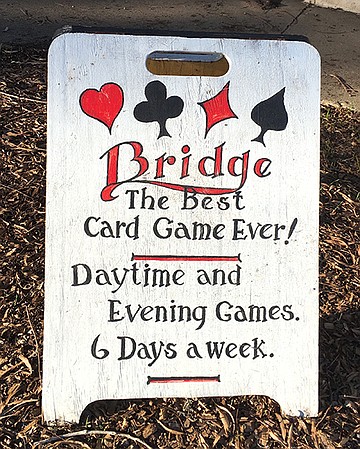 Facebook
Facebook
 X
X
 Instagram
Instagram
 TikTok
TikTok
 Youtube
Youtube

“I didn’t know people still played bridge.” “I guess you could say it’s extremely vulgar. I like it a lot.”
— Exchange from Whit Stillman’s excellent movie Metropolitan, which came out in 1990, 17 years before the bridge-centric third season of Noah Hawley’s excellent TV series Fargo.

“The City of San Diego has three buildings dedicated to bridge,” says David Walters. “There’s a building right on the cove in La Jolla, and the Soledad Club across the street from Kate Sessions Park.” And there’s Balboa Park’s Redwood Bridge Club on Sixth, where Walters serves as manager, in addition to running The San Diego Bridge Academy. The Redwood Club has been running since 1948, but when Walters arrived in 2006, “they were kind of in decay. They had five games a week, and no night games except on Thursdays.”

Now they’re running at least three times that, with over 100 people per game paying $10 for three hours and change of intense, pair-based competition. “They’re playing duplicate bridge, which is how you get better. You shuffle the deck, deal the cards, and play the hand. You score it up, and then the hand stays intact and gets played at each table. You’re ranked according to how well you and your partner played that hand.” You also get to study how the competition played it, and maybe hash out with your partner what you could have done differently. (“It’s like a marriage,” says Walters.) “Every two or three years, we add another game, because I keep teaching new people. It’s on the upswing.”
What happened to, um, bridge the gap between 1990 and 2017? “In the ‘50s, you couldn’t really go to college without knowing how to play bridge. Then in the ‘60s, when everybody revolted against the previous generation, it fell out of favor. In the ‘70s and ‘80s, it became regarded as an old ladies’ game” — though that didn’t stop Walters from discovering it as his true vocation and delight while working as a backpacking ranger at Philmont Scout Ranch during his college years. And now that those revolting rebels are reaching retirement age, and now that “you have all kinds of studies coming out about how it helps prevent memory decay, Baby Boomers are my new customer base.”
But Walters isn’t selling a memory aide. “Bridge is the best card game,” he says with perfect ease. Pinochle, with its bids, trumps, and points, is a sort of primitive precursor, but “if you had to compare it to other games, I’d say tennis and golf, where you can always get better, but you can never master it. It will always humble you. I became an expert by playing 40 hours a week for fifteen years. But it takes about five years to develop basic competence, and that’s why you need a good teacher.” And even then, “very few people make it out of the intermediate game room into the open game room.”
The San Diego Bridge Academy is offering its next six-week round of introductory classes starting January 14 (morning sessions) and 15 (evening sesisons). Visit sandiegobridgeacademy.com for details.


“I didn’t know people still played bridge.” “I guess you could say it’s extremely vulgar. I like it a lot.”
— Exchange from Whit Stillman’s excellent movie Metropolitan, which came out in 1990, 17 years before the bridge-centric third season of Noah Hawley’s excellent TV series Fargo.

“The City of San Diego has three buildings dedicated to bridge,” says David Walters. “There’s a building right on the cove in La Jolla, and the Soledad Club across the street from Kate Sessions Park.” And there’s Balboa Park’s Redwood Bridge Club on Sixth, where Walters serves as manager, in addition to running The San Diego Bridge Academy. The Redwood Club has been running since 1948, but when Walters arrived in 2006, “they were kind of in decay. They had five games a week, and no night games except on Thursdays.”

Now they’re running at least three times that, with over 100 people per game paying $10 for three hours and change of intense, pair-based competition. “They’re playing duplicate bridge, which is how you get better. You shuffle the deck, deal the cards, and play the hand. You score it up, and then the hand stays intact and gets played at each table. You’re ranked according to how well you and your partner played that hand.” You also get to study how the competition played it, and maybe hash out with your partner what you could have done differently. (“It’s like a marriage,” says Walters.) “Every two or three years, we add another game, because I keep teaching new people. It’s on the upswing.”
What happened to, um, bridge the gap between 1990 and 2017? “In the ‘50s, you couldn’t really go to college without knowing how to play bridge. Then in the ‘60s, when everybody revolted against the previous generation, it fell out of favor. In the ‘70s and ‘80s, it became regarded as an old ladies’ game” — though that didn’t stop Walters from discovering it as his true vocation and delight while working as a backpacking ranger at Philmont Scout Ranch during his college years. And now that those revolting rebels are reaching retirement age, and now that “you have all kinds of studies coming out about how it helps prevent memory decay, Baby Boomers are my new customer base.”
But Walters isn’t selling a memory aide. “Bridge is the best card game,” he says with perfect ease. Pinochle, with its bids, trumps, and points, is a sort of primitive precursor, but “if you had to compare it to other games, I’d say tennis and golf, where you can always get better, but you can never master it. It will always humble you. I became an expert by playing 40 hours a week for fifteen years. But it takes about five years to develop basic competence, and that’s why you need a good teacher.” And even then, “very few people make it out of the intermediate game room into the open game room.”
The San Diego Bridge Academy is offering its next six-week round of introductory classes starting January 14 (morning sessions) and 15 (evening sesisons). Visit sandiegobridgeacademy.com for details.
Comments